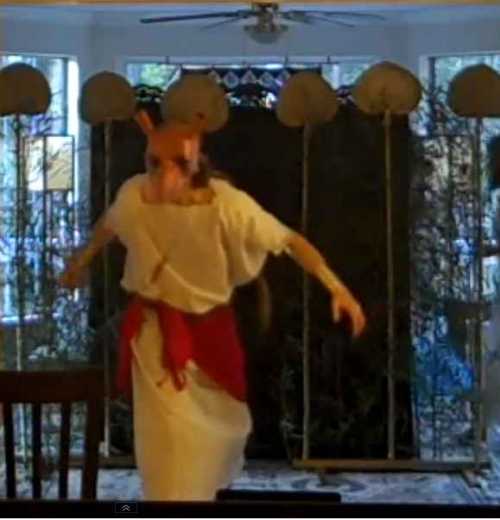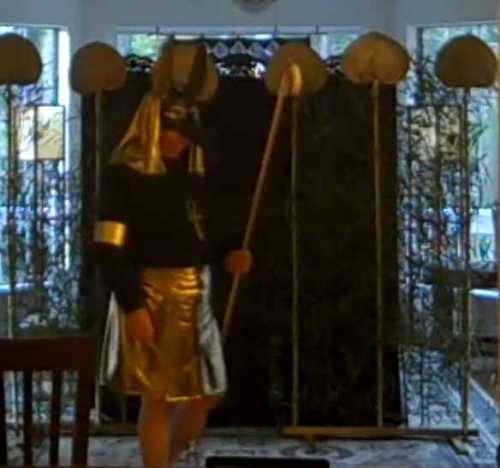 Each of the past five years Temple Osireion has remembered the journey of the soul through the Duat with a ritual drama. We do this around the first of November, a time when it is natural to embrace the darker season, ponder the afterlife, and imagine meeting the gods. The journey through the Duat is one of the grand myths which provides a metaphor for personal and community growth. It is arduous, confusing, transforming and, ultimately, regenerative.
Each of the past five years Temple Osireion has remembered the journey of the soul through the Duat with a ritual drama. We do this around the first of November, a time when it is natural to embrace the darker season, ponder the afterlife, and imagine meeting the gods. The journey through the Duat is one of the grand myths which provides a metaphor for personal and community growth. It is arduous, confusing, transforming and, ultimately, regenerative.
With the regeneration comes a rebirth into the dawn of a new day. The ancient texts tell of Osiris’ transformation into Ra, of Ra’s transformation from an old, dying neteru back into the young hawk that bursts from the eastern akhet (horizon) into flight across the day.
Pool of Lotus has for three years brought messages that we hope have shed a bit of light on new Egyptian practice, encouraged those on a Kemetic-inspired path, and better connected Egyptian religion to the contemporary Pagan movement. As with many journeys, it is time to look ahead to a new morning, a next new way of being.
In the coming year I will be directing my focus on finishing my graduate degree at Cherry Hill Seminary, so it seems wise to bring Pool of Lotus to a close. My heartfelt thanks goes to the editor of Witches and Pagans, Anne Niven, for opening this opportunity to me in 2012. Your encouragement, advice and support are a treasure for which I will always be grateful. Blessings of peace to all.
A god has been born now that I have been born:
I see and have sight,
I have my existence,
I am lifted up upon my place,
I have accomplished what has been decreed . . .
(Book of the Dead, 174)
Come, come in peace, O glorious Eye of Heru.
Be strong and renew your youth in peace,
for the flame shines like Ra on the double horizon.
I am pure, I am pure, I am pure, I am pure.
(From “Great Rite Honoring Djehuty,” Eternal Egypt by Richard Reidy)
-
 Thank you for reading and for your kind comment, Brea.
Thank you for reading and for your kind comment, Brea.




 Once upon a time in Egypt, back when the Nile was free to flood and recede, the harvest season (Shemu) was at its height about now. Planting would have happened in our late fall (Peret); the inundation would come again in mid- or late-summer (Akhet). Renenutet and Aset (Isis) were two of the goddesses who were honored during this season that most of us know as the vernal equinox.
Once upon a time in Egypt, back when the Nile was free to flood and recede, the harvest season (Shemu) was at its height about now. Planting would have happened in our late fall (Peret); the inundation would come again in mid- or late-summer (Akhet). Renenutet and Aset (Isis) were two of the goddesses who were honored during this season that most of us know as the vernal equinox.

 Come to your house, Osiris!
Come to your house, Osiris! The ancients carried a memory of the great ones who came before them, the children of Ra named Osiris, Isis, Nephthys and Set (the Egyptians called them Asar, Aset, Nebt-Het and Sety). Firstborn and king Osiris, with his sister wife Isis, ruled the land with care, teaching the people to weave linen, make papyrus, brew beer and wine, and beautify (embalm) their dead.
The ancients carried a memory of the great ones who came before them, the children of Ra named Osiris, Isis, Nephthys and Set (the Egyptians called them Asar, Aset, Nebt-Het and Sety). Firstborn and king Osiris, with his sister wife Isis, ruled the land with care, teaching the people to weave linen, make papyrus, brew beer and wine, and beautify (embalm) their dead. The festival opened with a procession in the streets led by a priest wearing the mask of Anubis (Anpu). The soon-inebriated crowd re-enacted the murder of Osiris by his brother Set. Inside the temple, priests conducted the sacred rituals in private. Two priestesses played the parts of Isis and her sister Nephthys, each reciting a solemn lamentation. The first day, the priests placed seeds in a coffin-like container with water and soil. On the third day of the festival the priests opened the container to reveal that the buried seeds, like Osiris, had germinated and come to life.
The festival opened with a procession in the streets led by a priest wearing the mask of Anubis (Anpu). The soon-inebriated crowd re-enacted the murder of Osiris by his brother Set. Inside the temple, priests conducted the sacred rituals in private. Two priestesses played the parts of Isis and her sister Nephthys, each reciting a solemn lamentation. The first day, the priests placed seeds in a coffin-like container with water and soil. On the third day of the festival the priests opened the container to reveal that the buried seeds, like Osiris, had germinated and come to life.
 In the silence of the night the waters were troubled. We did not know that far to the south, in the headwaters of the great river, rains swelled the flow, sending the fertile black earth our way. What we did know was that the star of Sopdet, whom we know as Aset (Isis), had disappeared from the sky for weeks now. Each evening the priests watched for it to reappear at the horizon, the signal that Aset was weeping, mourning the loss of her husband Asar (Osiris). After dark there is no way to see if a crocodile lies in wait or a hyena quietly stalks you coming home late. Except in the cities, the silence here is vast, incomprehensible. Against that quiet, the change in the water showed itself in little lappings higher up the bank, a swath of new green advancing up the shores on both sides.
In the silence of the night the waters were troubled. We did not know that far to the south, in the headwaters of the great river, rains swelled the flow, sending the fertile black earth our way. What we did know was that the star of Sopdet, whom we know as Aset (Isis), had disappeared from the sky for weeks now. Each evening the priests watched for it to reappear at the horizon, the signal that Aset was weeping, mourning the loss of her husband Asar (Osiris). After dark there is no way to see if a crocodile lies in wait or a hyena quietly stalks you coming home late. Except in the cities, the silence here is vast, incomprehensible. Against that quiet, the change in the water showed itself in little lappings higher up the bank, a swath of new green advancing up the shores on both sides. Mut-i Nut, herak-a. My mother Nut, hail to you. You who hold a thousand starry souls in your lapis body, whose arms and legs are the pillars of the sky, who separates the earthly realm from the chaos of darkness. Mut-i Nut, you gave birth to the great ones in the barque of the Ennead, Asar, Aset, Nebt-Het, and mischievous Set. Mut-i Nut, you receive the blessed dead, the shining ones.
Mut-i Nut, herak-a. My mother Nut, hail to you. You who hold a thousand starry souls in your lapis body, whose arms and legs are the pillars of the sky, who separates the earthly realm from the chaos of darkness. Mut-i Nut, you gave birth to the great ones in the barque of the Ennead, Asar, Aset, Nebt-Het, and mischievous Set. Mut-i Nut, you receive the blessed dead, the shining ones.










